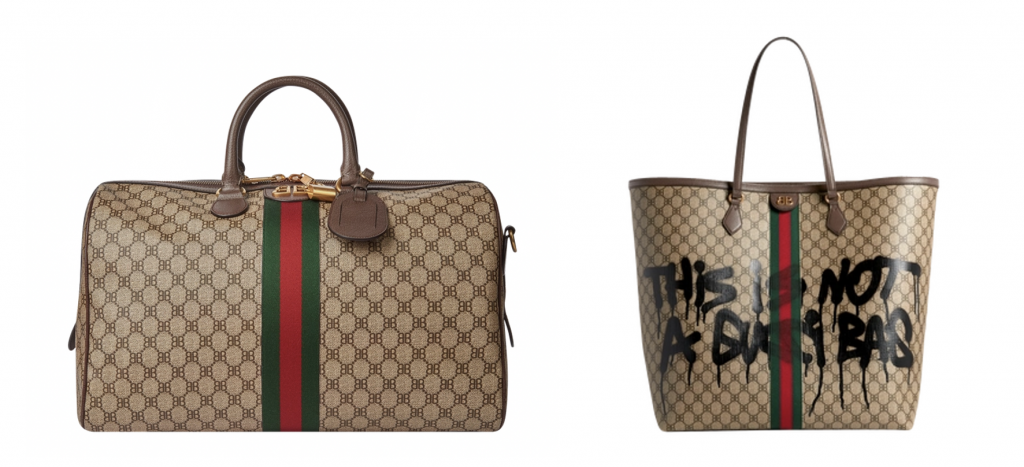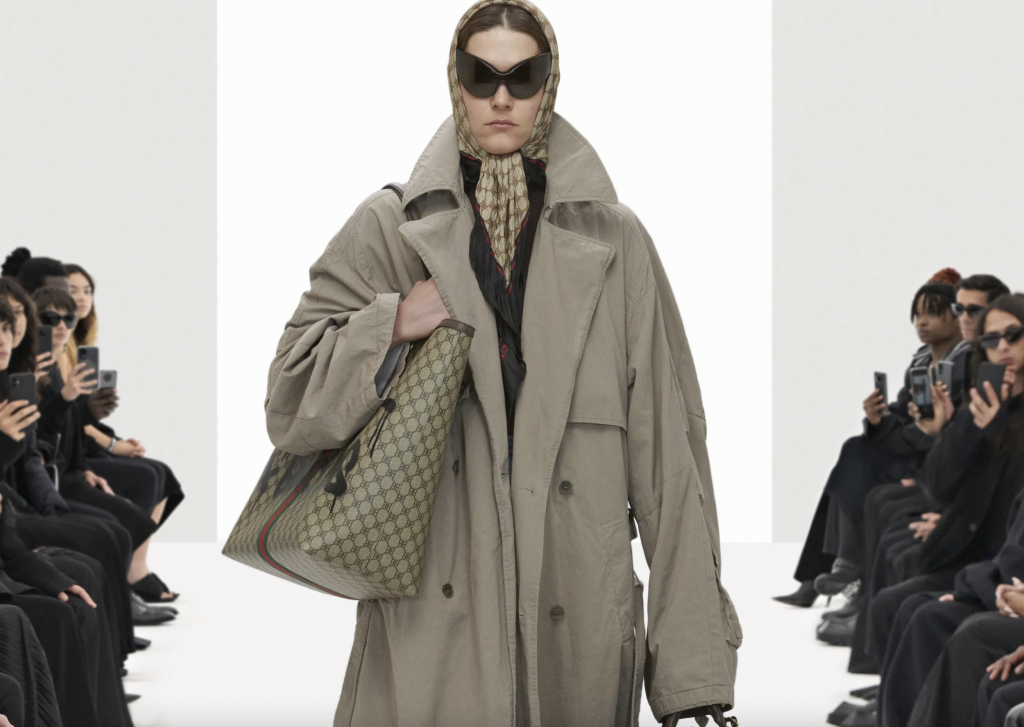Gucci and Balenciaga continued the “hacking” project that they first showed in April as part of Gucci’s sweeping Aria collection – albeit instead of Gucci taking Balenciaga house codes and mashing them up with its famous branding, for its Spring/Summer 2022 collection, Balenciaga presented “conceptual interpretations of Gucci’s recognizable signatures as Balenciaga products.” More specifically, in the video that it released on Sunday, Balenciaga inserted its “BB” logo into Gucci’s famous house pattern, and splashed it on cross-body bags, duffles and totes (a limited number of which were also tagged with “This is not a Gucci bag”), scarves, belts, and its fellow Kering-owned brand’s hot-selling Jackie 1961 bag.
The impetus for the ongoing mish-mash of brand assets? There is the inevitable commercial draw of the collection and its potentially limited-season wares, with Balenciaga’s take particularly likely to spark the interest of young Chinese luxury buyers in the same way as Gucci’s is expected to once the Aria collection makes it was to stores. At the same time, Balenciaga will almost certainly enjoy a boost in engagement online, as the newly-revealed collection parlays some of the interest in Gucci’s heavily-hyped Gucci reveal of co-branded wares this spring. The debut of its Aria collection reached a “record audience,” Kering revealed in its Q1 conference call in April, and is expected to help boost the brand’s average selling price, something that may also hold true for Balenciaga.
Still yet, there is a conceptual element behind the move to mash up the two brands’ iconography. In an interview with Vogue’s Sarah Mower, Balenciaga creative director Demna Gvasalia said the collection plays into the question of the divide between “what’s real and what’s fake,” particularly when it comes to what we see online. While he says that he differs quite a bit from Gucci chief creative Alessandro Michele, Gvasalia claims that they “both like to question this whole question around branding and appropriation … because everyone does it, whether they say it or not.”

Reflecting on the “perfectly oxymoronic range of ‘genuine counterfeits,’” herself, which Gucci has explored in the past by way of its “Fake,” “Not Fake” offerings, Mower states that they are “surely a mischief-making dig at the social media court of who’s-copied-who,” and interestingly asserts, “Whether it actually matters who produces whatever in fashion anymore seems to be the big contention being raised.” Here, of course, it does not really matter which brand made what (or whose logo is whose), as the money made from “these co-branded souvenirs will go safely back to Balenciaga and Gucci’s parent company Kering,” which ultimately owns all of the intellectual property at issue – from Gucci’s green-red-green stripe to Balenciaga’s prominently-placed “B” logo.
Ultimately, in adopting this enduring co-branding approach between two of its buzziest brands (according to recent rankings, such as Luxe Digital’s “15 Most Popular Luxury Brands Online” list), Kering is dealing in a decidedly successful trend in the Asian market (and beyond), which is the real cash cow for the luxury goods industry as a whole. The Asian Pacific region was responsible for 35 percent of Kering’s revenues for the 2020 fiscal year, after all, followed by North America, which generated 21 percent. And in its FY20 revenue report, Kering highlighted the sheer might of the Chinese consumer, stating that Gucci, in particular, was buoyed by “robust and encouraging sales momentum” among local buyers in Mainland China.
Proving particularly compelling in China’s hyper-competitive market, where conventional marketing methods are no longer effective, companies with strong common interests – Gucci and Balenciaga, included – are looking to co-branded collaborations as a way to attract luxury buyers. If done well, such partnerships are “a powerful legal and marketing tool that uses the cross-licensing of trademarks from different companies to brand a new product” in order to “mutually increase their customer bases, sales channels, market share, customer loyalty, brand image, positive associations, and perceived value,” according to Beijing-based Rouse attorneys Josh Mandell and Ya Wen. By tying the very-valuable trademarks of two of its brands together, Kering is once again angling for double the impact, and offering consumers two-times the branding for the price of one.
Also worthy of note in the collection: the model. It turns out, Eliza Douglas donned each of the looks for the virtual runway show thanks to deepfake technology and CG-scanning.











